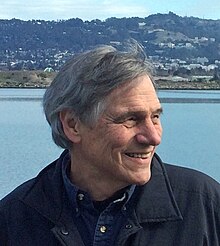| Mark R. Morris | |
|---|---|
 | |
| Born | 1947 |
| Education | University of California, Riverside (BA) University of Chicago (PhD) |
| Spouse | Francoise Queval |
| Children | 2 |
| Awards | UCLA Distinguished Teaching Award (2004) |
| Scientific career | |
| Fields | Astrophysics |
| Institutions | Columbia University University of California, Los Angeles |
| Doctoral students | Don Figer |
Mark R. Morris (born 1947) is an American astrophysicist. He earned his B.A. magna cum laude at the University of California, Riverside and his Ph.D. in Physics at the University of Chicago. He did his postdoctoral work at the Owens Valley Radio Observatory, California Institute of Technology, and was on the faculty of the Department of Physics at Columbia University. Since 1985 he has been a professor in the Department of Physics and Astronomy at the University of California, Los Angeles.
He is a founding member and Associate Director of the UCLA Galactic Center Group along with Eric Becklin and Andrea Ghez. The UCLA Galactic Center group uses images from the Keck Observatory to map the orbits of stars bound to the Milky Way's supermassive black hole, enabling a test of general relativity. Morris received the UCLA Distinguished Teaching Award in 2004.
Morris has worked extensively on multiwavelength studies of the Galactic Center, including a review article and he was co-discoverer of the extensive radio arcs present there. He continues to study high energy phenomena in the Galactic Center, including an X-ray fountain, radio structures connected to the central black hole Sgr A*, and star formation, including the detection of one of the most luminous stars in the Milky Way.

His early work included landmark theoretical and observational studies of mass loss in the advanced stages of evolution of red giant stars, including examples of spectacular mass loss in red giants.
References
- "About the Galactic Center Group". UCLA Galactic Center Group.
- "Distinguished Teaching Award Recipients". UCLA Academic Senate. 2017-06-28.
- Baganoff, F. K.; Maeda, Y.; Morris, M.; Bautz, M. W.; Brandt, W. N.; Cui, W.; Doty, J. P.; Feigelson, E. D.; Garmire, G. P.; Pravdo, S. H.; Ricker, G. R.; Townsley, L. K. (10 July 2003). "X‐Ray Spectroscopic Imaging of Sagittarius A* and the Central Parsec of the Galaxy". The Astrophysical Journal. 591 (2): 891–915. arXiv:astro-ph/0102151. doi:10.1086/375145.
- Morris, Mark (May 1993). "Massive star formation near the Galactic center and the fate of the stellar remnants". The Astrophysical Journal. 408: 496. Bibcode:1993ApJ...408..496M. doi:10.1086/172607.
- Morris, Mark R. (16 April 2018). "Bounteous black holes at the Galactic Centre". Nature. 556 (7701): 319–320. Bibcode:2018Natur.556..319M. doi:10.1038/d41586-018-04341-8. PMID 29662134.
- Crockett, Christopher. "Giant X-ray 'chimneys' are exhaust vents for vast energies produced at Milky Way's center". UCLA Newsroom.
- Wilford, John (October 8, 1997). "At the Core of the Milky Way, The Brightest Star Ever Seen". The New York Times. New York Times.
- Morris, Mark (November 1987). "Mechanisms for mass loss from cool stars". Publications of the Astronomical Society of the Pacific. 99: 1115. Bibcode:1987PASP...99.1115M. doi:10.1086/132089.
- Knapp, G. R.; Morris, M. (May 1985). "Mass loss from evolved stars. III. Mass loss rates for fifty stars from CO J = 1-0 observations". The Astrophysical Journal. 292 (published 1985): 640. Bibcode:1985ApJ...292..640K. doi:10.1086/163197. ISSN 2041-8205. Wikidata Q68590167.
- "Hubble Detects Giant 'Cannonballs' Shooting From Star". NASA Hubblesite.